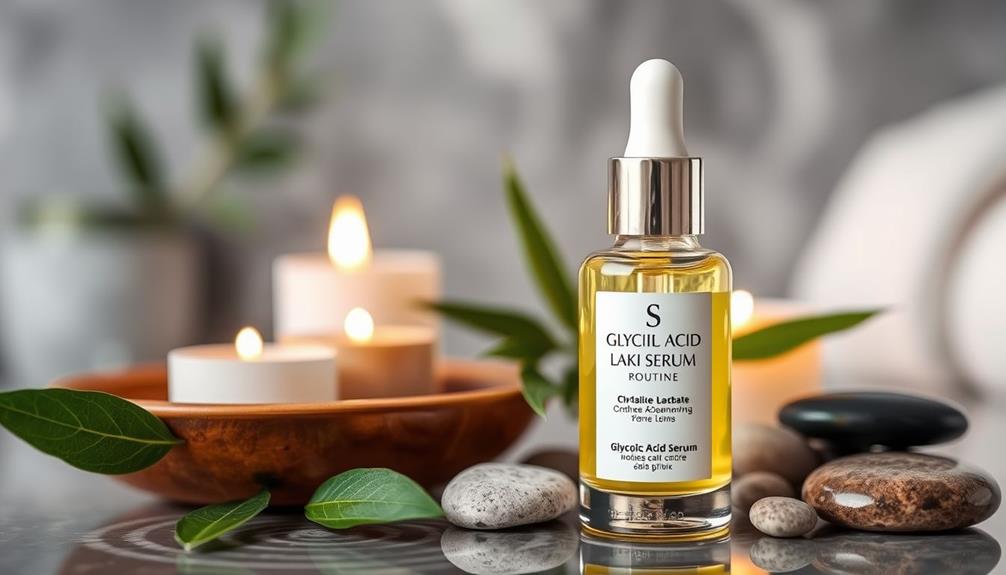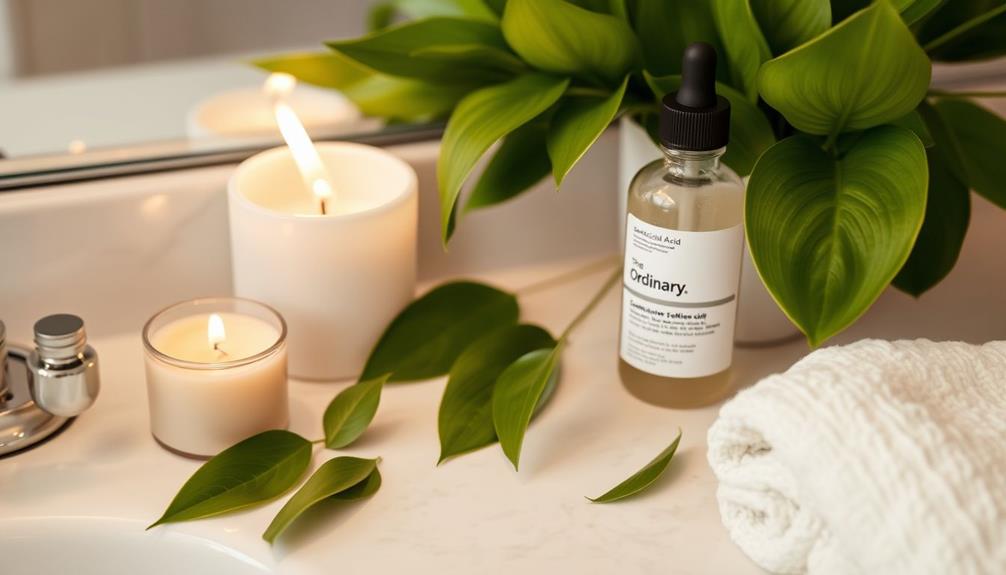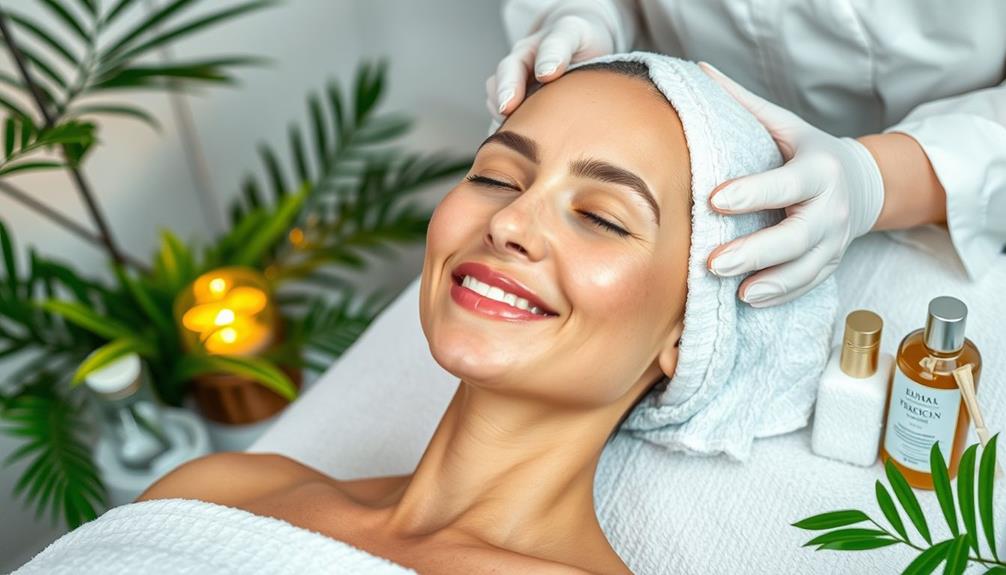Glycolic acid is a beneficial ingredient to include in your hair care routine as it can provide unexpected advantages. It helps exfoliate the scalp by removing dead skin cells, creating a healthy environment for hair growth. Additionally, it improves moisture retention, resulting in softer, shinier hair with less frizz. Moreover, it aids in balancing pH levels, allowing other hair products to work more effectively. To enjoy these benefits, apply a low-concentration glycolic acid product to your scalp once or twice a week. However, if you have sensitive skin, proceed with caution. Exploring other tips can further enhance your hair care routine and ensure your hair looks its best!
Key Takeaways
- Glycolic acid exfoliates the scalp, removing dead skin cells that can clog hair follicles and promote a healthier environment for hair growth.
- It enhances moisture retention in hair strands, leading to softer hair and improved hydration levels.
- The acid helps improve product absorption and effectiveness by balancing pH levels, reducing breakage and enhancing overall hair health.
- Regular use can increase hair shine and reduce frizz, supporting a vibrant appearance and vitality.
What Is Glycolic Acid?
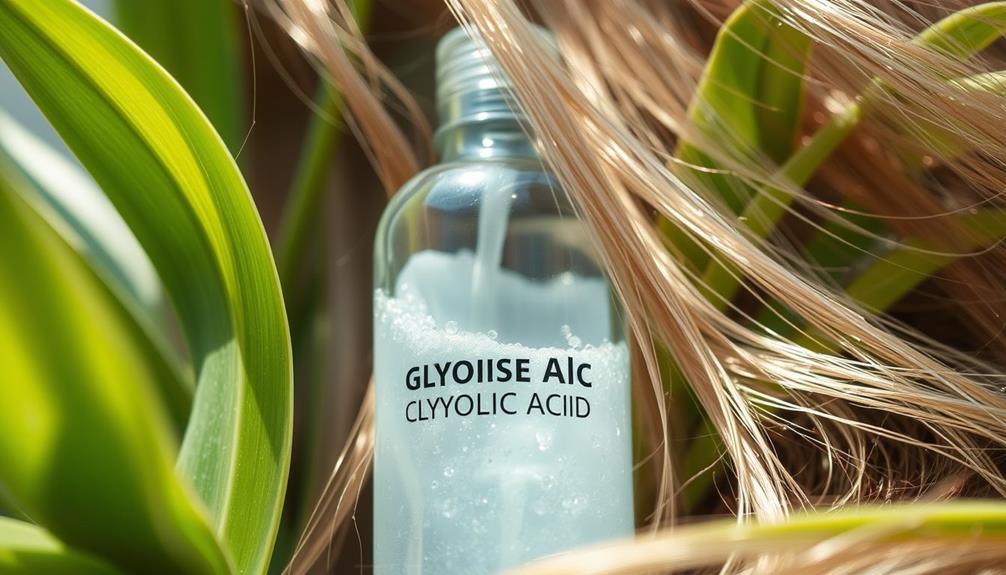
What exactly is glycolic acid? It's an alpha hydroxy acid (AHA) derived from sugarcane, known for its ability to exfoliate dead skin cells and promote cellular turnover. This powerful ingredient is one of the smallest AHAs, making it particularly effective in penetrating hair cuticles.
When you use hair care products containing glycolic acid, you harness the benefits of glycolic acid for your hair, as it works to remove impurities and buildup. Additionally, incorporating essential oils, such as rosemary or lavender, can further enhance scalp health and stimulate hair growth, creating a synergistic effect for hair liveliness. essential oils for hair growth
Incorporating glycolic acid into your hair care routine can enhance your hair's overall health and appearance. By helping to exfoliate dead skin cells from the scalp, glycolic acid not only creates a cleaner environment for hair growth but also improves the alignment of hair cuticles. This can lead to shinier, more vibrant hair that reflects light beautifully.
Typically, glycolic acid concentrations in hair care products range from 5-7%, making it safe and effective when applied as directed.
Benefits for Hair Health

Glycolic acid offers powerful benefits for your hair health, especially when it comes to scalp exfoliation and moisture retention.
By removing impurities and dead skin cells, it promotes a healthier scalp environment while keeping your hair hydrated and soft.
Regular use can also enhance the effectiveness of your hair care products, similar to how understanding a cat's body language is key to interpreting its feelings and needs environmental enrichment.
You'll notice improved shine and reduced frizz, making your hair look and feel revitalized.
Scalp Exfoliation Benefits
Exfoliating your scalp with glycolic acid can greatly enhance hair health by removing dead skin cells and creating a more conducive environment for growth.
As an effective exfoliant, glycolic acid helps clear away the buildup of dead skin cells that can clog hair follicles. This action not only promotes healthy hair growth but also prevents common scalp issues like dandruff and scalp acne.
In addition to these benefits, incorporating aromatherapy techniques such as essential oils can further support scalp health and relaxation.
By maintaining ideal scalp health, glycolic acid balances pH levels, which can improve the absorption of your hair care products. This is essential for ensuring that your hair receives all the nutrients it needs.
Regular use of glycolic acid can lead to a smoother and more vibrant hair texture by promoting the alignment of hair cuticles.
Additionally, a clean scalp allows for better moisture retention, which can help minimize breakage.
By incorporating glycolic acid into your routine, you're not just treating your scalp; you're investing in the overall health of your hair.
Enhanced Hair Moisture
Release enhanced hair moisture with glycolic acid, which boosts hydration levels and transforms your hair into a softer, more manageable mane. This powerful ingredient works wonders by increasing moisture retention in your hair strands, providing you with that coveted silky feel.
Glycolic acid's exfoliating properties clear away dead skin and buildup on your scalp, creating a healthier environment that allows for better hydration. Additionally, regular trims from local salons can complement the effects of glycolic acid by promoting healthier hair growth and enhancing overall appearance consultations recommended.
By balancing your scalp's pH levels, glycolic acid promotes moisture retention and reduces dryness, which is essential for maintaining vibrant, shiny hair. If you have damaged hair caused by hard water, you'll find that glycolic acid can greatly improve your hair's ability to absorb moisture.
As a result, you'll notice enhanced softness and a reduction in hair breakage, leading to stronger, more resilient locks.
Regular use of hair care products containing glycolic acid can be a game-changer for your hair health. Experience the benefits of this remarkable ingredient and say goodbye to dryness and frizz, while enjoying a smoother, more luminous mane that reflects your inner radiance.
Application Techniques
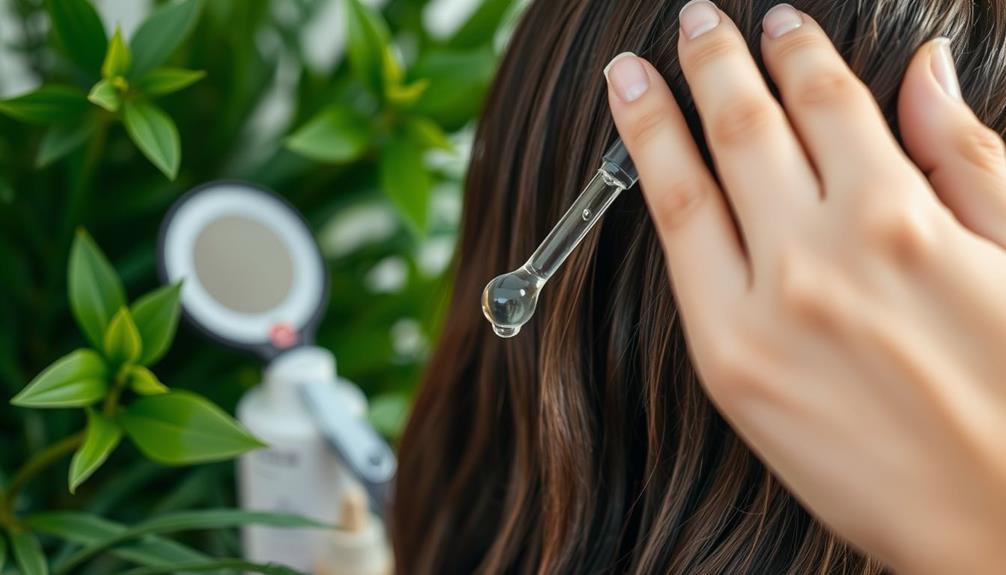
When applying glycolic acid for hair health, use a low-concentration serum or toner directly on your scalp, massaging it in for better absorption. It's crucial to choose products containing 5-7% glycolic acid, as higher concentrations can cause irritation and should only be used under professional supervision.
Once you've applied the product, leave it on your scalp for 20-30 minutes. This allows for effective exfoliation and moisture retention, giving your hair the best chance to thrive.
For maximum results, consider making glycolic acid part of your evening hair care routine. Applying it at night helps minimize UV sensitivity, protecting your scalp from potential sunburn. Always follow the specific product instructions, as each formulation might've unique guidelines for application.
Incorporating these application techniques into your hair care routine can help prevent clogged follicles and promote overall scalp health. Regular use of glycolic acid can lead to softer hair and reduced breakage, making it a valuable addition to your regimen.
Frequency of Use

When using glycolic acid for your hair, it's important to establish a recommended application schedule.
You should aim for once or twice a week, adjusting based on how your scalp responds.
Keeping an eye on your hair's health will help you find the ideal frequency for your needs.
Additionally, much like how Jenna Elfman's recent projects showcase her versatility, experimenting with different application frequencies can lead to discovering what works best for your specific hair type.
Recommended Application Schedule
For ideal results, apply glycolic acid treatments weekly to confirm your scalp has adequate time to recover. This frequency supports peak scalp exfoliation and enhances hair health.
Incorporating body awareness techniques can also contribute to a more holistic approach to your personal care routine, allowing you to connect with your body on a deeper level self-exploration through body awareness.
If you're new to glycolic acid, start with a lower concentration (around 5%) and gradually increase to higher levels (up to 10%) as your scalp adjusts.
When you use glycolic acid hair products, leave them on your scalp for 20-30 minutes to maximize their benefits. Pay attention to how your hair and scalp respond; if you have an oily scalp, you might find more frequent applications beneficial. However, if your scalp is sensitive or dry, it's best to reduce the frequency to avoid irritation.
For best results, consider applying these treatments in the evening. This helps minimize potential sun sensitivity after application.
After rinsing out the glycolic acid, don't forget to follow up with a moisturizing conditioner to maintain hydration and keep your hair looking its best.
Optimal Frequency Guidelines
Determining the ideal frequency of glycolic acid use is vital to maximizing its benefits for your hair and scalp. Generally, you should aim to apply glycolic acid treatments once or twice a week, but this can vary based on your hair type and condition.
For scalp exfoliation, opt for a low-concentration glycolic acid serum (around 5-7%) that you can leave on for 20-30 minutes before rinsing. This approach helps maintain a healthy scalp while enhancing your hair care routine.
If you're considering higher concentration products (above 10%), it's essential to use them less frequently and under professional supervision. These potent formulas can provide significant benefits, but they also come with a risk of irritation.
Regular use can lead to improved hair health, shine, and moisture retention, but pay close attention to your scalp sensitivity.
Always consult product instructions or a dermatologist for personalized recommendations on the ideal frequency of glycolic acid use, ensuring you get the best results without compromising your scalp's health.
Adjust your routine based on how your scalp reacts, and you'll enjoy the full rewards of this powerful ingredient.
Risks and Precautions

Using glycolic acid on your scalp carries several risks and precautions that you should be aware of to guarantee your safety and comfort.
If you have sensitive skin, sores, or conditions like a very dry scalp, it's best to avoid using glycolic acid, as it can exacerbate these issues. Furthermore, if you've recently undergone chemical treatments or have allergies to alpha hydroxy acids (AHAs), steer clear of this ingredient to prevent adverse reactions.
Be mindful of potential side effects, such as scalp irritation, which may include redness and itchiness. Overdrying of your scalp and hair is also a risk, so it's essential to follow recommended application times and concentrations. In addition, glycolic acid can increase your sensitivity to UV radiation, making it advisable to apply treatments in the evening to reduce the likelihood of sunburn.
Always start with a patch test to see how your scalp reacts. If you experience any discomfort, discontinue use immediately. By taking these precautions, you can enjoy the benefits of glycolic acid while minimizing any negative effects on your scalp and hair.
Alternatives to Glycolic Acid
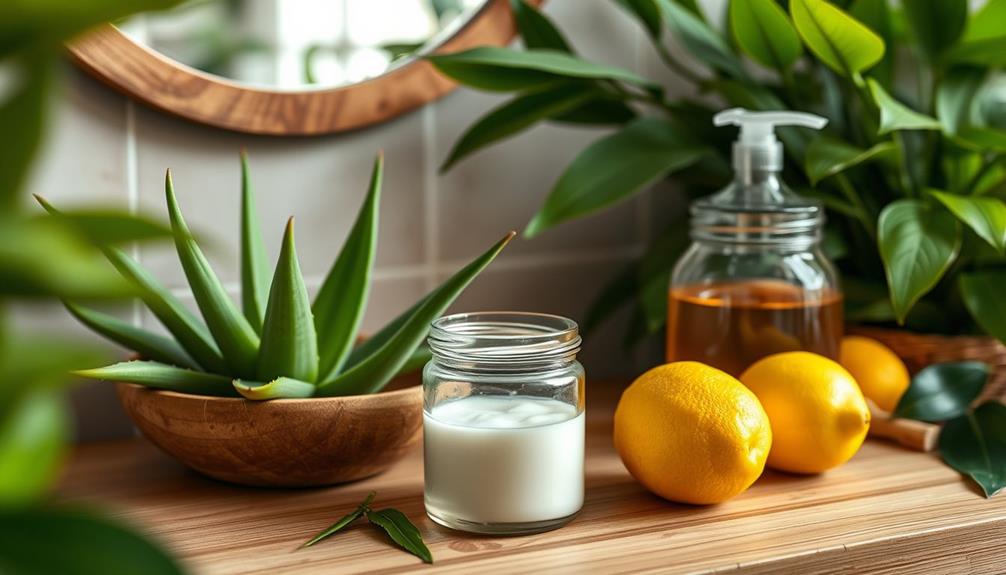
If glycolic acid isn't the right choice for your hair care needs, several effective alternatives can help promote hair growth and improve scalp health. Here are some options to evaluate:
- Minoxidil: This topical treatment is widely used for hair loss and is effective in stimulating hair growth for both men and women dealing with androgenetic alopecia.
- Finasteride: Primarily targeting androgenetic alopecia in men, finasteride can be a powerful alternative. However, it's not recommended for premenopausal women due to potential hormonal side effects.
- Steroid Creams: Formulated for hair loss, these can reduce inflammation and promote hair regrowth, especially beneficial for conditions like alopecia areata.
- Anti-fungal Shampoos: Look for acid-containing ingredients like ketoconazole or salicylic acid. These can treat scalp conditions like dandruff or seborrheic dermatitis that contribute to hair loss.
Incorporating these alternatives into your hair care routine can help you achieve healthier hair and a thriving scalp without relying solely on glycolic acid. Always consult with a professional to determine the best option for your specific needs.
Causes of Hair Loss
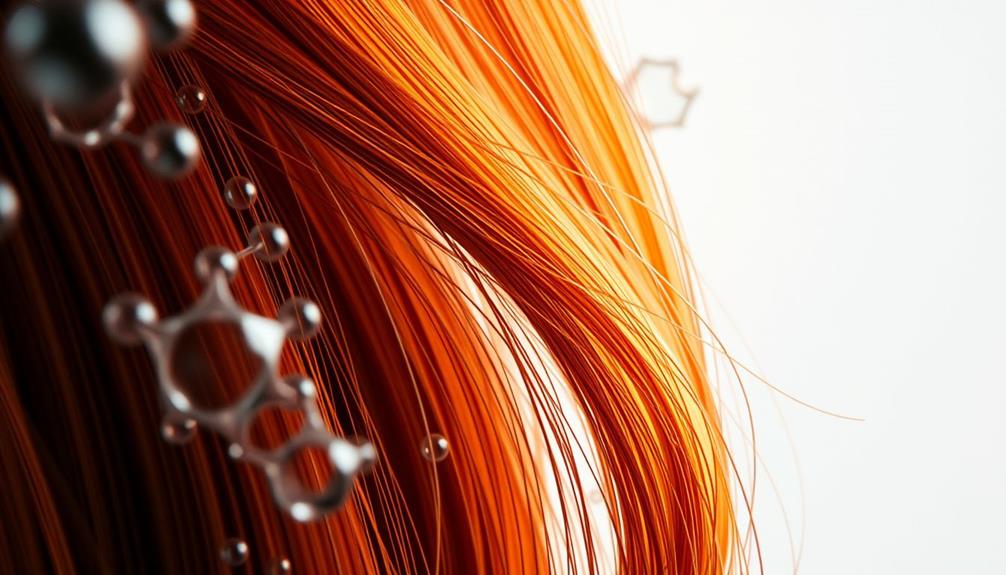
Hair loss can stem from various factors, including genetics, medical conditions, and lifestyle choices, making it essential to understand the underlying causes. Different hair types react differently to these factors, and certain skin conditions can exacerbate hair loss. Here's a quick overview of common causes:
| Cause | Description |
|---|---|
| Androgenetic Alopecia | A hereditary condition causing progressive thinning in both men and women. |
| Alopecia Areata | An autoimmune disorder leading to sudden patchy hair loss in individuals of all ages. |
| Telogen Effluvium | Temporary hair loss triggered by stress, hormonal changes, or nutritional deficiencies. |
| Traction Alopecia | Gradual hair loss due to tight hairstyles, especially along the hairline. |
Using glycolic acid in your hair care routine might help improve scalp health, particularly for treated hair. It can exfoliate the scalp, potentially benefiting individuals dealing with specific skin conditions that contribute to hair loss. By addressing these causes, you can take proactive steps towards healthier hair.
Popular Hair Care Trends

Understanding the causes of hair loss can lead you to explore popular hair care trends that address these issues effectively. Today, consumers are gravitating toward solutions that not only improve hair health but also fit their lifestyle choices. Here are four trends worth noting:
- Glycolic Acid Treatments: Many are turning to professional cosmetic treatments featuring glycolic acid, known for its ability to enhance hair texture and health.
- Budget-Friendly Hair Masks: Affordable masks targeting frizzy hair are gaining traction, providing effective solutions without breaking the bank.
- Natural Ingredients: There's an increasing preference for chemical-free hair care products, reflecting a desire for clean beauty and environmentally friendly options.
- Holistic Hair Care: More individuals are adopting holistic approaches, combining dietary changes with effective product use to promote overall hair wellness.
Frequently Asked Questions
What Does Glycolic Acid Do to Hair?
Glycolic acid penetrates your hair, removing impurities and calcium deposits. It improves moisture retention, enhances flexibility, and boosts thermal stability, making your hair softer, smoother, and more resilient against damage from styling and environmental factors.
What Happens if You Leave Glycolic Acid on Too Long on Hair?
Leaving glycolic acid on too long can turn your scalp into a fiery mess! You risk irritation, dryness, and even chemical burns. Stick to the recommended time to keep your hair and scalp happy and healthy.
What Are the Cons of Glycolic Acid on Scalp?
When using glycolic acid on your scalp, you might experience irritation, redness, or dryness. Overuse can lead to chemical burns or increased sensitivity to sunlight, so always proceed with caution and consider your skin's sensitivity.
Does Glycolic Acid Break Hair Bonds?
Imagine your hair strands intertwined like delicate threads. Glycolic acid doesn't break these bonds; instead, it strengthens them. It enhances flexibility, reduces breakage, and promotes a healthier appearance, making your hair resilient and vibrant.
Conclusion
Incorporating glycolic acid into your hair care routine can truly transform your locks.
You'll notice improved texture, reduced buildup, and enhanced shine, all while tackling common issues like dryness and frizz.
Just remember to use it wisely and pay attention to your hair's needs.
With the right balance, you'll reveal a vibrant, healthy mane.
So, why not give it a try? You might just discover the secret to your best hair yet!


